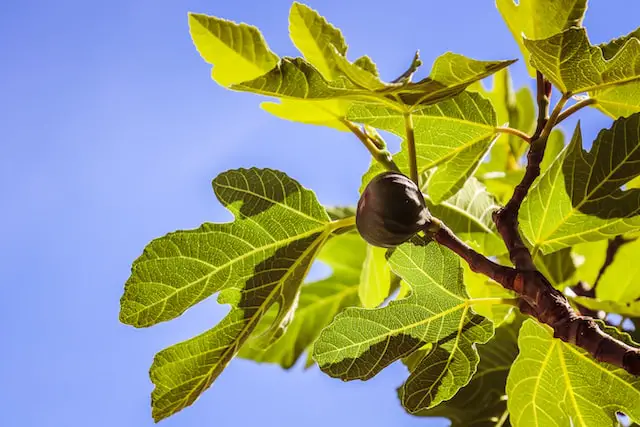
The rewards of growing a fig tree are undeniable – they are beautiful, relatively easy to care for, and the flavor of homegrown figs is infinitely superior to store-bought. But a gardener who decides to grow figs first has to answer this question: Do I plant my fig tree in the ground or in a pot?
In-ground fig trees grow larger, produce more fruit, and require less maintenance than potted trees. Container-grown figs stay compact, are easy to protect from cold weather, and can still provide a good harvest. Consider climate, space, and amount of care when determining the best growing option.
As with so many gardening questions, the right answer for you depends on several factors: fig variety, growing conditions, climate, and even how attentive (or lazy) you are as a gardener. Below we examine the considerations for growing fig trees in the ground vs. in containers.
Size and Space
In-Ground Fig Trees
In-ground fig trees will most likely grow larger and faster since their roots have room to seek out available nutrients. Fig trees, which originally grew in the Mediterranean, prefer slightly “poor” soil that is well-draining, mildly acidic, and not too rich. Find out more about the best place to plant fig trees here.
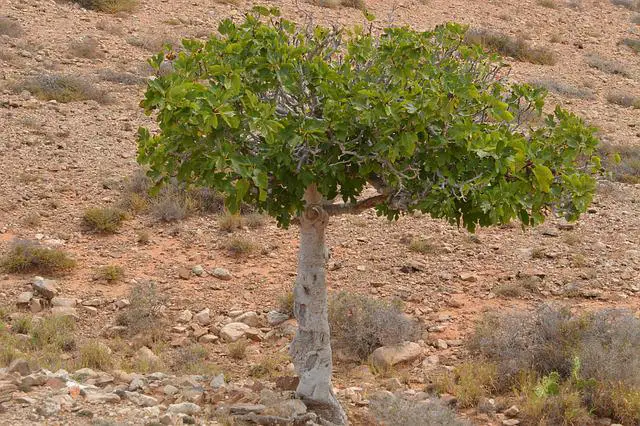
At any size, a fig tree planted in the ground can serve as a focal point in the landscape. The dark green, deeply lobed leaves, widespread canopy, and dangling jewel-like fruit make a good contrast to other ornamental plants.
If your soil or location is not ideal, particularly if the soil is too rich in nitrogen (as it can be if you frequently fertilize your lawn), then the fig tree might grow too vigorously. The plant will exhibit excessive leafy growth and not set fruit as well. In general, a larger tree will mean more figs, but accidental over-fertilization can harm fruit production.
Potted Fig Trees
Any variety of fig tree will stay more compact when planted in a container. Even in a large pot, a fig tree’s vigorous roots are restricted by space and lack of nutrients. A smaller tree will mean less fruit, but you can maximize your potted fig’s production with proper care.

Some fig tree cultivars are bred to stay very small (such as ‘Little Miss Figgy’), making them well suited to container planting (14 Fantastic Figs for Growing in Containers). This is perfect for small yards – you can grow delicious figs even if space is limited. Even when they are not fruiting, potted fig trees are a beautiful addition to a deck, patio, or other small space.
Ease of Care
Potted Fig Trees
A container-grown fig tree has less soil, fewer nutrients and microbes in the soil, and limited room for root growth – which means more work for you, the gardener. A pot is an unnatural growing environment for fig trees. All of the resources that they could find in nature (water, food, sun) have to be provided for them.
Potted fig trees need frequent watering throughout the growing season, especially in hotter climates. The nutrients in the pot get used up quickly, so a regular fertilizing regimen is required for healthy growth and maximum fruit potential (read about when and how to fertilize fig trees in this article).
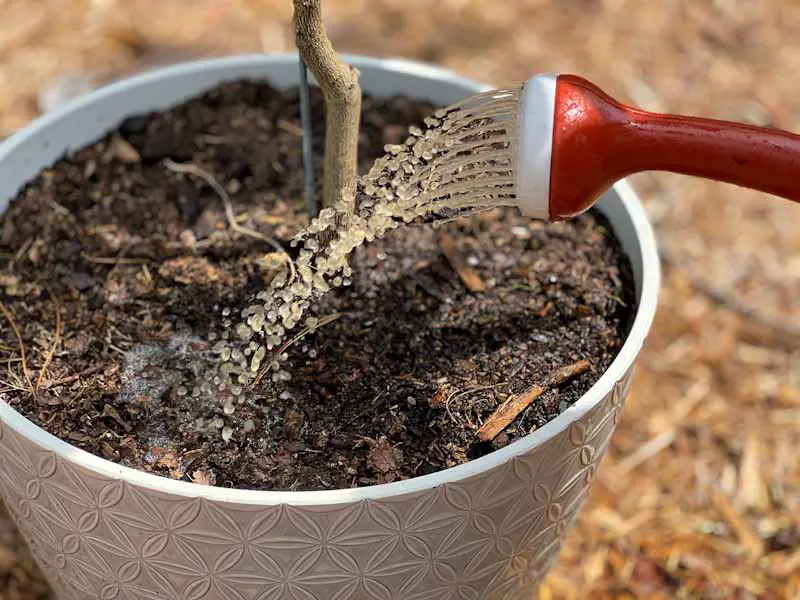
Every 2-3 years, fig trees need to be repotted and planted in fresh potting mix (The Best Potting Soil for Fig Trees). Repotting in a bigger pot will encourage the tree (and roots) to continue growing. If your pot is large enough, then the fig tree can be replanted in that same pot with new soil. Before placing in the pot, up to 25% of the root ball can be trimmed to keep the tree from becoming potbound.
In-Ground Fig Trees
A fig tree planted in the ground has roots extensive enough to access the nutrients and water it needs. It requires minimal pruning, additional watering only in dry spells, and little to no fertilizer.
Depending on the soil, some fertilization may be required (particularly at the beginning of the growing season). But with fig trees, under-fertilizing is a safer bet than over-fertilizing. (Fertilizing Fig Trees: 8 Times it’s NOT Necessary).
Winter Protection
In-Ground Fig Trees
Most fig trees are hardy to zone 7 or 8 (about 10-20°F), but some varieties can be grown in colder zones (such as ‘Chicago Hardy’). If you live in a warmer climate, then you’re lucky enough to be able to plant fig trees in the ground without additional cold-weather protection.
In northern climates, your fig tree may experience some dieback over the winter if unprotected. Planting a fig tree against a south-facing wall can help create a slightly warmer microclimate and provide some shelter for the tree. Fig trees can recover after partial cold damage; spring will bring new growth, and the tree may even produce fruit that same season.
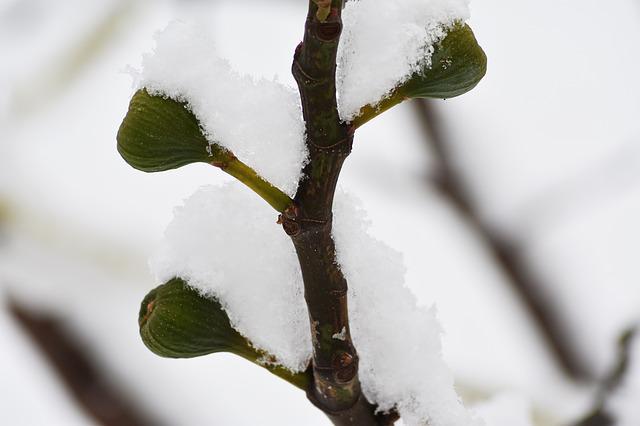
In colder zones, even if the tree is labeled as hardy, it’s advisable to mulch and/or wrap the tree to protect it from extreme cold. Before the first frost, place a thick layer (at least 4-6 inches) of mulch around the base of the tree to protect the shallow roots. For more protection, wrap the tree in burlap, canvas, an old quilt, or anything that will insulate the tree but allow for some air circulation.
Potted Fig Trees
Container figs have an advantage for cold-weather protection: they are moveable. Many potted fig growers keep their pots on wheeled plant stands for ease of movement (a wheelbarrow works too). Before the first frost, after the tree has lost its leaves, simply roll the tree into a shed, garage, or other unheated space to shelter it for the winter.
It’s important that the space you store it in is cold, but protected from frost – you don’t want to trick the fig tree into thinking it’s spring too early. That dormant time is important for the tree to store up energy for the growing season.
In the spring, reacclimate the potted tree gradually to the outdoors to avoid shock. Bring the tree outside for a couple of hours each day, increasing little by little until the tree is ready to be back outside full time.
Fruit Production
Potted Fig Trees
Fig trees that have their roots restricted can actually fruit better than those planted in an abundance of fertile soil. Fig trees laden with figs are often seen in southern Europe growing out of craggy walls, crevices in the pavement, or small stone planters.
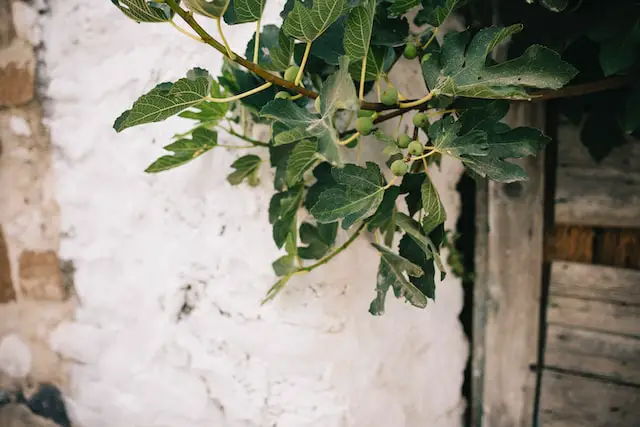
Fruiting is a survival instinct of the plant; if the tree’s roots don’t have much room, the tree will put its energy into reproduction (growing figs) rather than establishing an extensive root system. A potted fig tree also may fruit sooner than an in-ground tree planted at the same time; again, the potted fig has more resources available for setting fruit setting rather than growing roots.
If you don’t have great conditions for planting a fig tree in the ground, containers allow you to still grow good quality fruit. Studies show that a small potted fig tree can produce 2 to 3 pounds of fruit in a season, or as many as 10-15 figs per gallon. In other words, a fig tree in a 10-gallon container could produce 100-150 figs if well cared for.
In-Ground Fig Trees
Fig trees in the ground have the advantage of size – generally, a bigger tree equals more figs. It may take a year or two longer to produce fruit than a container tree, but an in-ground tree will yield more fruit in the long run as the tree grows larger.
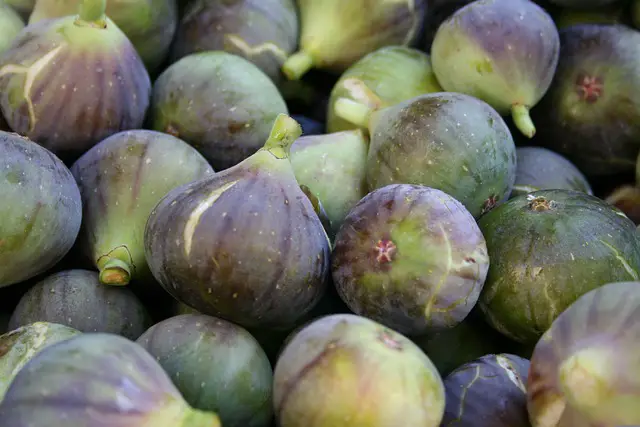
Grown in the right conditions, figs from an in-ground tree will probably be of higher quality, too. The better you can approximate a fig tree’s natural growing environment (well-draining, slightly acidic, not-too-fertile soil, etc.), the better its figs will taste.
If your tree is growing too vigorously and not producing many figs, it is possible to restrict the root growth in the ground. Many growers recommend planting fig trees near a wall or other barrier, occasionally pruning roots, or burying pavers vertically around the fig tree’s root ball to keep the roots somewhat in check.
The results of these methods are mixed, however, and the lack of fruiting could be due to other issues – see 11 Reasons Your Fig Tree Isn’t Fruiting (and What to Do) to find out more. According to this study, a 7-year-old fig tree growing in good conditions can produce about 55 lbs of figs, and a more mature tree could yield an even larger harvest.

